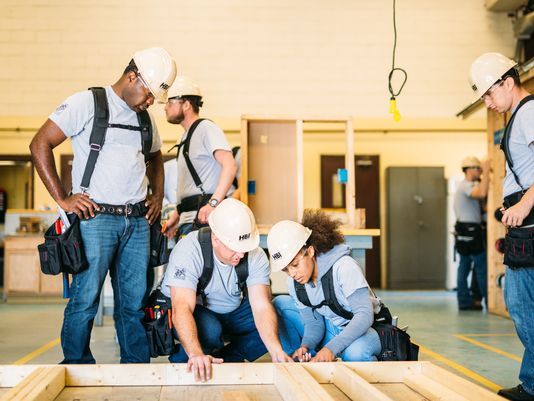(Photo: Julia Fenner, PullSpark)
Home Depot announced Thursday that it will donate $50 million to train 20,000 people as construction workers over the next decade, helping efforts to ease a dire shortage that’s curtailing home building and driving up house prices.
The Home Builders Institute, the industry’s education arm, will use the money from the Home Depot Foundation to train veterans and U.S. Army soldiers who will soon be returning to civilian life, high school students and disadvantaged youth.
“It’s important that we support the trades,” Home Depot CEO Craig Menear said in an interview. “Not only do we sell product to professionals like plumbers and electricians,” but the company also partners with service providers that install kitchen flooring, hot water heaters and other equipment in consumers’ homes.
Focus on veterans
Sales at the nation’s largest home-improvement retailer are dampened if contractors and partners can’t find enough workers to undertake projects. Sales to plumbers and other tradespeople comprise 40% of the company’s revenue, Menear says.
The initiative, he says, also builds on the company’s donation of $250 million through 2020 to provide housing to veterans. Soldiers and veterans will make up about 15,000 of the 20,000 construction workers turned out by the training program.
They could make a noticeable dent in a big problem. There were 158,000 job openings in construction in December, up from 140,000 a year earlier. Eighty-four percent of contractors surveyed by the National Association of Home Builders (NAHB) and Wells Fargo in December cited availability of workers and cost as their most significant problems last year, along with rising materials prices.
Labor crunch
Residential construction employment fell by 1.5 million during the housing crash, and payrolls have risen by just 786,000 since the recovery began in 2011. Many workers left the industry for oil, factory and trucking jobs during the meltdown. Meanwhile, Baby Boomers are retiring from the field in droves and there aren’t nearly enough replacements coming out of high schools, which have placed less emphasis on vocational education in recent years.
The worker shortage is taking a toll. About 900,000 single-family houses are expected to be built this year, but there’s demand for nearly 1.3 million, says Robert Dietz, chief economist of NAHB.
The labor crunch leads the obstacles to closing that gap, including rising materials prices, the limited availability of land and onerous regulations. As a result of low housing supplies, existing-home sales fell for the second straight month in January and the median sales price was up 5.8% annually to $240,500.
Looking for steady funding
The Home Builders Institute (HBI) is training about 3,500 construction workers a year, says CEO John Courson. But the money, which comes from the Labor Department, states, and local workforce boards, is precarious, with HBI perennially scrambling to renew grants. The Home Depot program will increase the number of graduates who receive certificates by 2,000 a year for the next decade, or nearly 60%.
“This is going to take us to a new level,” Courson says. “We’re going to have a partner” to provide a stable funding source.
The effort will also substantially increase the number of soldiers and veterans schooled in construction. HBI has trained 120 soldiers a year for the past four years; the Home Depot funds will add another 1,500 annually. They represent an optimal pool of job candidates.
“They love to work with their hands, they work well in a team and they’re used to being outdoors and the elements,” he says.
Soldier students
An initial group of 40 soldiers at Fort Stewart in Georgia and Fort Bragg in North Carolina are set to graduate from the Home Depot-funded course at the end of the month. In 12 weeks, soldiers receive classroom instruction as well as hands-on training in specialties such as carpentry, framing, plumbing and electrical work. Graduates go on to apprenticeships or permanent jobs with builders that can pay upwards of $50,000.
Kyle Narruhn, 23, a trainee at Fort Stewart, says he always dreamed of becoming an officer but doesn’t want to be away from his future family for long periods.
“I was really confused,” says Narruhn, a mechanic who served a tour in Iraq. “I didn’t know what to do. I’ve never lived a civilian life.” The construction program “clears a path” for a career, probably as a welder.
A bigger pipeline
The program is one of several efforts to create a bigger pipeline of new construction workers across the country. With the value of a college degree increasingly being questioned, high schools are starting to revive vocational educational classes. HBI has licensed its curriculum to 36 high schools the past two years and another 40 are strongly considering signing on, Courson says.
Major hiring sprees are planned in the United States for two major home improvement retailers. Time
Last week, Lowe’s announced a pilot program to give $2,500 to employees in Charlotte, Pittsburgh, Denver and Richmond, Va., who are interested in taking an online construction course to possibly switch careers.
George Hess, CEO of Vantage Homes Colorado Springs, Colo., would welcome the additional labor. He plans to build about 120 houses this year but says he could increase the total by 20% if subcontracting crews had enough workers. Workers sometimes walk off his job sites after being offered slightly more pay by a rival.
“That’s the stuff that makes you pull your hair out,” he says.
Contributing: Charisse Jones

